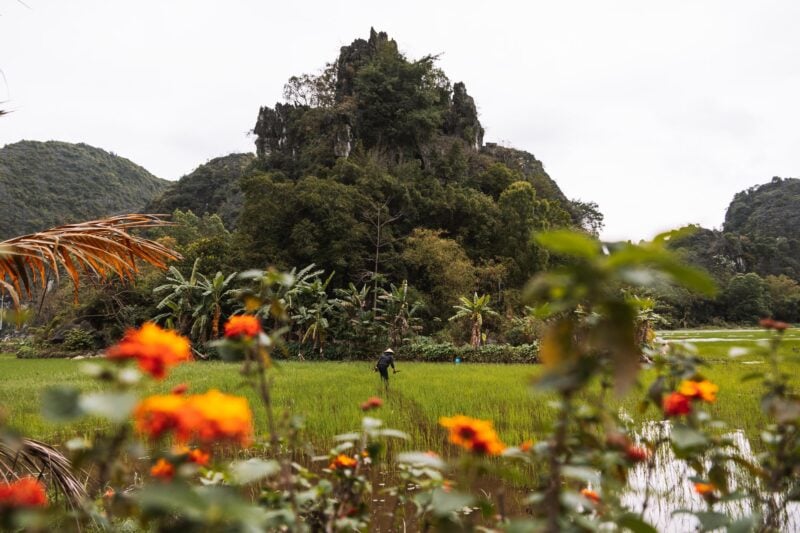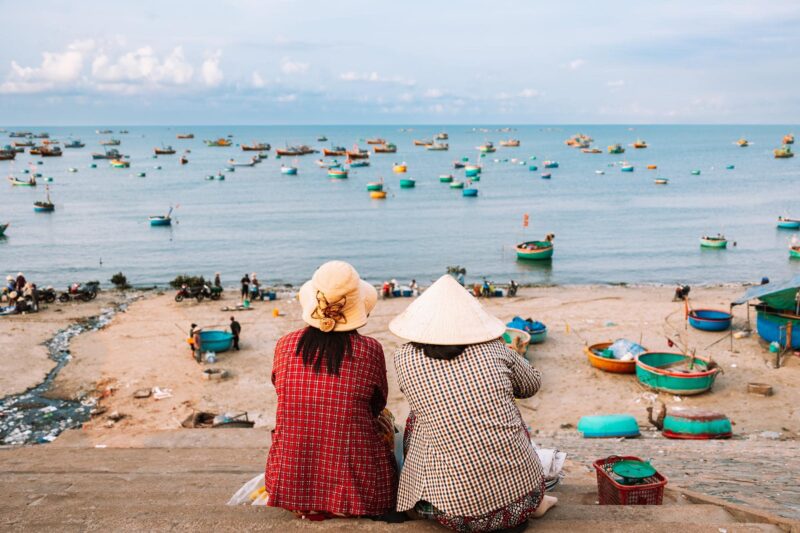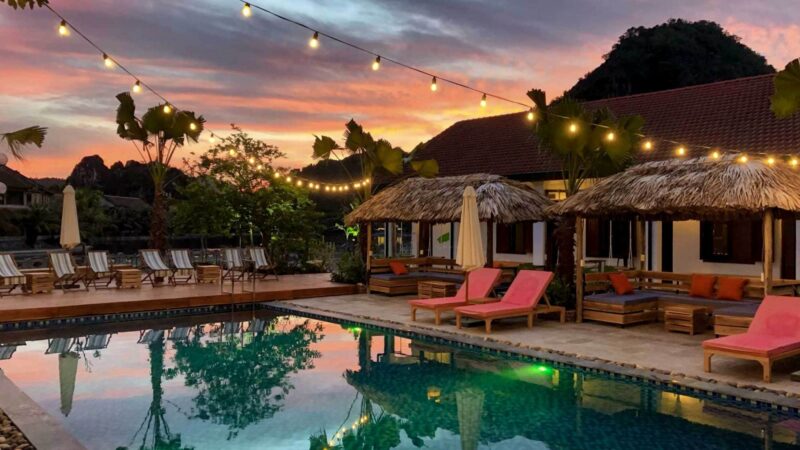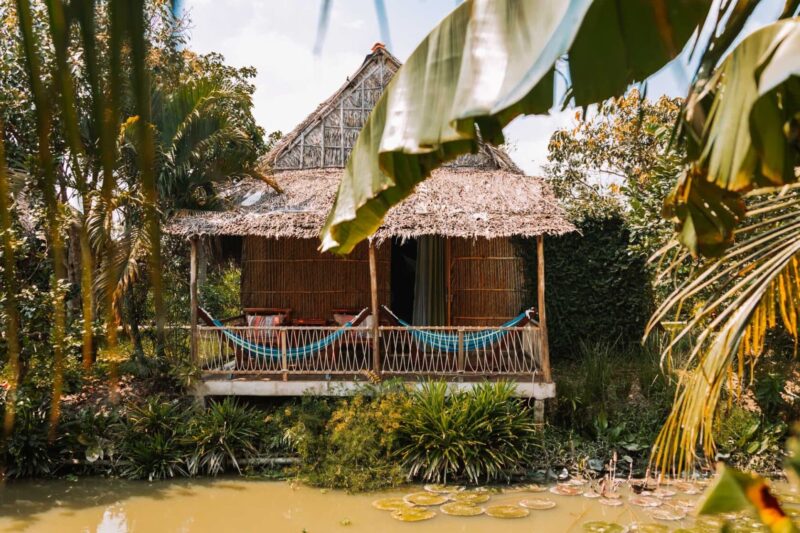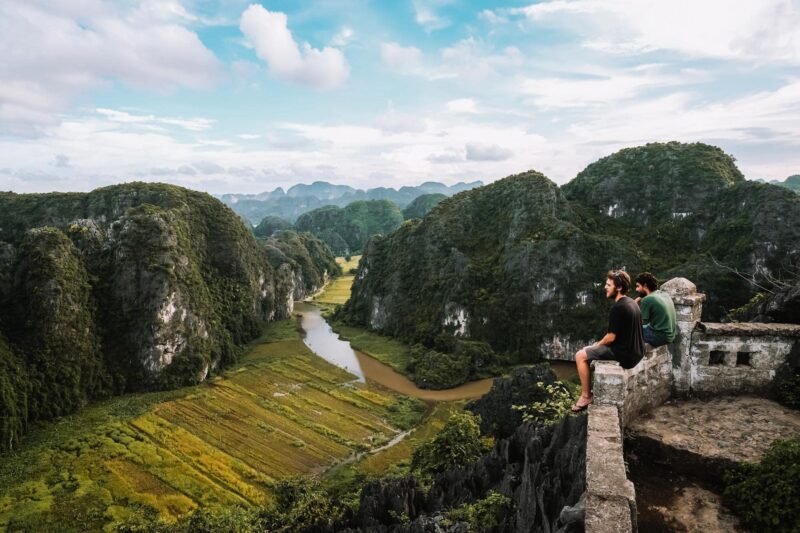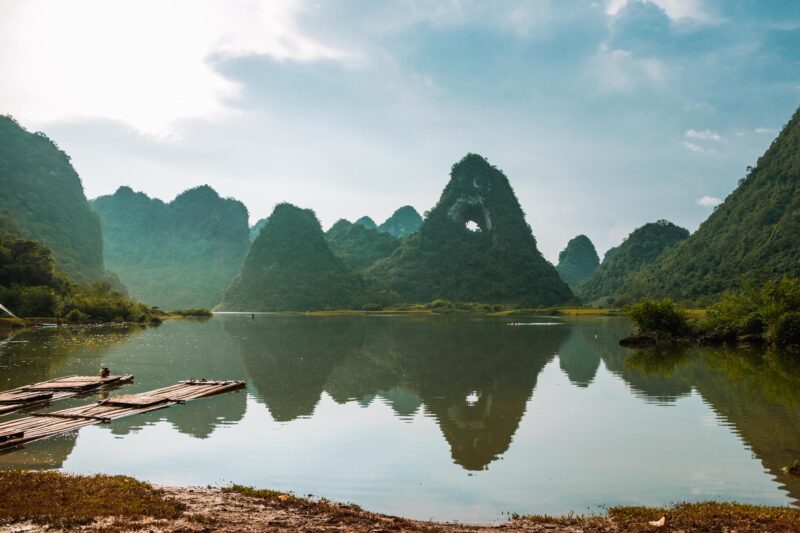If you’re looking for an unforgettable adventure, the Ha Giang Loop is one of the most exciting things to do in Vietnam. During this four-day road trip, you’ll explore the most beautiful places in Northern Vietnam. You have the option to hop on the back of a motorbike with an “easyrider,” drive the motorbike yourself, or even take the route by car with a driver. The winding mountain roads will take you past enormous limestone rock formations, lush rice terraces, and panoramic viewpoints. Along the way, you’ll visit authentic villages and immerse yourself in the different cultures of the region. This unique experience will stay with you for a lifetime and is sure to be a highlight of your trip. Below, I’ll share my itinerary for exploring the Ha Giang Loop and provide some practical tips.
The Ha Giang Loop in Brief
The Ha Giang Loop is approximately 350 kilometers (217 miles) long and one of the most famous motorbike routes in Southeast Asia. This itinerary takes you through the stunning province of Ha Giang. Spread throughout the province are 700,000 inhabitants belonging to various ethnic minority groups. Ha Giang used to be a region primarily visited by travelers going off the beaten path, but it has become increasingly popular in recent years. This is not surprising because for many, it’s their favorite part of Vietnam. Despite the growing number of visitors, the province has retained its authenticity, and you’ll have the chance to meet the diverse and welcoming local people.
Driving the Ha Giang Loop Yourself, Riding as a Passenger, or Using a Car?
The winding mountain roads are generally well-maintained, but some sections can be challenging, especially in adverse weather conditions. So, think carefully about whether you want to drive the Ha Giang Loop yourself, ride as a passenger with an easyrider, or choose a car with a driver. An easyrider is a guide and driver in one who takes you as a passenger on their motorbike. They ride in groups of various sizes. If you have enough experience and an international motorcycle license, you can also choose to drive the challenging route yourself. Whether with or without an easyrider, you can take a group tour, which makes the trip extra enjoyable. With a tour, everything is arranged for you, including your guide, accommodation, meals, transportation, and entrance fees, all included in the price. The most popular Ha Giang Loop tour lasts four days, but if you have less time, you can opt for the three-day tour. There are even two-day and five-day variants, but these are less common. The four-day tour allows you to see the most beautiful places, and I found this duration to be just right.
- 4-day Ha Giang Loop self-guided
- 4-day Ha Giang Loop with easyrider
- 3-day Ha Giang Loop with easyrider
- 3-day Ha Giang Loop by car with driver
Driving the Ha Giang Loop without a Tour
You can also choose to drive the Ha Giang Loop without a tour. There are both advantages and disadvantages to doing the Ha Giang Loop on your own. I’ve listed them below for you. In our opinion, taking a tour with or without an easyrider is the best option because it allows you to enjoy the Ha Giang Loop in a very relaxed manner.
Advantages of doing the Ha Giang Loop without a tour:
- It offers a lot of freedom.
- It provides an adventurous feeling.
- You can set your own pace.
- It can be more budget-friendly.
Disadvantages of doing the Ha Giang Loop without a tour:
- You need to figure out what to do with your luggage.
- You have to rent a motorbike and arrange insurance on your own.
- You need to apply for a permit from the Ha Giang immigration office to stay in certain parts of the province.
- The route is not pre-planned, and you have to arrange your own accommodations.
- Locals speak little to no English, making communication a significant challenge without a guide.
Ha Giang Loop with a Car and Driver
Nowadays, it’s also possible to do the Ha Giang Loop with a car and driver. This is ideal for families who want to explore this beautiful region but don’t want to ride on a motorbike. The route may sometimes be slightly different because the car cannot access the small mountain paths, but you’ll still see the same beautiful places and plenty of winding mountain passes.
Ha Giang Loop Riding with an Easyrider
I chose to ride the Ha Giang Loop on the back of a motorbike with an easyrider. An easyrider is a Vietnamese-English speaking guide who can tell you everything about Vietnam and act as a bridge between you and the locals. Since this region has not been visited by travelers for long, very few people here speak English. Riding with an easyrider was a fantastic experience for me. The entire route, including stops, meals, and accommodations, was well taken care of. The big advantage of riding on the back of a motorbike is that it doesn’t require any effort to drive yourself, allowing you to fully enjoy everything you see along the way. Even if you have a motorcycle license, an easyrider can still be a great choice in my opinion. It makes the Ha Giang Loop nice and “easy,” allowing you to simply enjoy the ride.
Day-by-Day Description of the Tour
The Ha Giang Loop can be completed in three, four, or five days. I chose to do the Ha Giang Loop in four days, which is the most common choice among travelers. This allows for sufficient breaks to stretch your legs and avoids riding too many miles on the motorbike. It was just right! Below, I’ll share the day-to-day itinerary. Please note that this can vary slightly depending on the tour operator and various factors such as weather conditions.
Day 1 of the Itinerary: Happiness Road, Co Thien Mountain, Heaven’s Gate, Quan Ba Village
You’ll start by riding the 200-kilometer-long (124-mile-long) Happiness Road, winding through the mountains and enjoying the first beautiful views. You’ll stop at Co Thien Mountain and then hike to Heaven’s Gate. Once there, at an altitude of 1500 meters (4921 feet) , you can admire the impressive mountain pass. In the afternoon, you’ll visit the small village of Quan Ba, where you’ll get a unique glimpse into local life as many people will invite you into their homes. They grow crops used to make linen as well as vegetables like corn and lettuce. Near Quan Ba Village, you’ll take a 30-minute walk to the Lung Khuy Cave. When you arrive at the cave, you can enjoy a great view of the valley. Hundreds of bats live in the dark cave, which you can hear but not see without shining your flashlight.
You’ll spend the first night at a guesthouse in the village of Nam Dam. You’ll have some time to relax and then enjoy a delicious meal. Afterward, you’ll likely be offered a glass of “happy water,” homemade rice wine. You’ll learn to toast in Vietnamese and may play some games or exchange stories with the group.
Total Distance: 65 kilometers (40 miles)
Tip: It’s highly appreciated if you buy some food or drinks in the local villages or, for example, a small souvenir.
Day 2 of the Itinerary: Lung Tam, Meo King Palace, Lung Cu Flag Tower
After breakfast, it’s about a thirty-minute drive to the village of Lung Tam. Here, you’ll meet the Hmong people and visit a family business that makes hemp linen. During your visit, you can witness the entire process and purchase a unique souvenir. These can range from traditional wall hangings to hand-printed clothing.
After this visit, you’ll head up towards Yen Minh and make a stop at a viewpoint along the way. You’ll visit the royal palace of the Hmong. The palace, built in 1889, has a total of 64 rooms. It features noticeable French influences, which are clearly seen in the palace’s architecture.
Next, you’ll enjoy lunch and continue the road trip to the Sung La Valley, where you can admire the Lung Cu Flag Tower. The Lung Cu Flag Tower sits at an altitude of 1400 meters (4593 feet), and the Vietnamese flag flies proudly at the top. The next stop is the town of Dong Vang, which offers numerous restaurants and cafes to enjoy your evening.
Total Distance: 130 kilometers (80 miles)
Tip: If you want to relax a bit after two days on the motorbike, consider booking a massage in Dong Vang.
Day 3 of the Itinerary: Tham Ma Pass, Ma Pi Leng Pass, Tu San Canyon, Nho Que River
Day three is filled with highlights. After the first ten minutes, you’ll stop at the famous Dốc Chín Khoanh, a striking winding mountain pass. You’ll have time to take some photos and visit a small museum where you can learn more about the history of the Ha Giang Loop.
After the first brief stop, you’ll ride along the impressive Ma Pi Leng Pass toward the Nho Que River. Along the way, there is much to see, and you’ll want to stop everywhere. The massive mountains that disappear into the clouds are mysterious, and you’ll see numerous small waterfalls flowing along the mountain edges. The Nho Que River flows into Vietnam from China and is situated right in the mountains. You’ll take a boat ride on the impressive lake and observe locals fishing on the water.
After the boat trip, you’ll ride for about an hour and a half on bumpy dirt roads. This is a challenging section, but you’ll be richly rewarded with a view of the Sa Li Pass. This was a highlight for me! Seeing all those winding mountain roads from above is amazing. You’ll spend the night in Du Gia Village.
Total Distance: 120 kilometers (74 miles)
Tip: If you happen to be in Dong Van on a Sunday, you can visit the local market there.
Day 4 of the Itinerary: Du Gia Waterfall, Minh Ngoc Pass & Return to Ha Giang City
In the morning, you’ll go on a beautiful hike to the Du Gia Waterfall, and then you’ll start the journey back to Ha Giang via the final mountain pass, Minh Ngoc Pass. Along the way, you’ll enjoy some more beautiful stops and a delicious final lunch.
Total Distance: 80 kilometers (50 miles)
Where Do You Stay During the Ha Giang Loop?
During this tour, you’ll sometimes stay in a guesthouse and sometimes in a hotel. The nights in a guesthouse are particularly special in my opinion. You sleep and eat with a local family in a traditional village, fully immersing yourself in Vietnamese culture. Usually, you’ll stay in a hotel in the town of Dong Vang. I found the variety to be quite nice because in the larger city, you also have the opportunity to dine at a restaurant, play pool together, or visit a karaoke bar.
Tip: Bring earplugs for a good night’s sleep. Guesthouses often have wooden walls and can be noisy.
Food and Drinks During the Tour
The Ha Giang Loop tour takes care of everything, including plenty of stops for food and drinks. The day often starts early with breakfast together. You can usually choose from toast with eggs or pancakes with bananas. Of course, Vietnamese noodles are also available for those who want to immerse themselves more in Vietnamese culture. Lunch is often very extensive. The table is filled with bowls of rice, cooked vegetables, chicken, pork, fried eggs, and spring rolls. You won’t go hungry during the Ha Giang Loop!
Tip: Don’t forget to bring enough cash for when you want to buy something delicious on the way.
Packing List for the Ha Giang Loop
It’s advisable to only bring the necessary luggage and leave your other belongings at your hotel or hostel in Ha Giang. Every traveler does this, and it’s not a problem. The guides bring plenty of drinking water for the journey every day, and you don’t need to bring your own rain gear or rain covers for your luggage. Below, I’ve made a small list of what’s handy to bring when you decide to ride the Ha Giang Loop.
- Hiking boots
- Rain gear (if you’re riding without a tour)
- Windbreaker
- Warm sweater
- Small backpack for day trips
- Swimwear and microfiber towel
- Toiletries
- Medications
- Clothing for the number of days
- Camera and chargers
- Power bank
- Sunscreen
- Cash
- Mosquito spray
- First aid kit (if you’re riding without a tour)
- Earplugs
The Best Time to Ride the Ha Giang Loop
The Ha Giang Loop can be ridden all year round, but the best time to travel is from November to March as this is the dry season for the region. There is less rainfall during this period, but it can be a bit colder. From April to May, there is more rain, but the landscape is incredibly colorful as everything is in bloom. In the months of June to September, there is the most rainfall, but you’ll get to see beautiful green rice fields in return. From September to October, the weather is usually pleasant with comfortable temperatures and lower humidity than in the summer.
As you can see, each season has its advantages and disadvantages, so the best time to ride the Ha Giang Loop depends on your personal preferences. I rode the Ha Giang Loop in August myself. We had occasional heavy showers along the way, but everything was beautifully green, and with good rain gear, it was still a fantastic road trip even in the rainy season.
Tip: Pack plenty of layers that you can easily put on and take off. Temperatures can change quickly in the mountains.

How to Travel to Ha Giang?
The starting point for the Ha Giang Loop is the city of Ha Giang itself. Most people travel there from Sapa, Hanoi, or Cao Bang.
From Sapa to Ha Giang
From Sapa, there are several daily buses to Ha Giang. The total bus journey takes about six hours, and you can pre-book bus tickets online.
Please note that this is a travel article, and the information provided here is based on the author’s experiences and research up to the knowledge cutoff date in January 2022. Travel conditions and regulations may have changed since then, so it’s essential to verify the latest travel information and requirements before planning your trip.
From Hanoi to Ha Giang
From Cao Bang to Ha Giang
Costs for the Ha Giang Loop
The prices of tours vary greatly and depend on the quality and what is included or not included in the tour. For a good tour, you should expect to pay around $270 to $300. Most of these tours include guides and/or easyriders, meals, snacks, entrance fees to attractions, rain gear, and accommodations. During the tour, you’ll only incur additional expenses if you decide to buy souvenirs along the way, and of course, it’s a good practice to tip the guides and/or easyriders after the tour. They will greatly appreciate it!
Here are some tour options again for your reference:
- 4 days Ha Giang Loop self-drive
- 4 days Ha Giang Loop with easyrider
- 3 days Ha Giang Loop with easyrider

Our Favorite Places to Stay in Ha Giang
One of the nicest places to stay is NoMadders Ha Giang. It’s a bit further from the city center, but when you stay here, you don’t need much else. There’s a large pool, delicious food, and a very cozy atmosphere. It’s the perfect place to meet other travelers and relax. Both the dorms and double rooms are comfortable, and the beds are super soft. Ha Giang Loop Hostel is a more budget-friendly hostel. It has a large garden with a small pool and plenty of seating areas. Ideal for meeting other backpackers. If you’re looking for more luxury, Ha Giang Historic House is perfect. The building is beautiful from the outside, and the interior is equally lovely. You’ll stay in a spacious room with air conditioning, heating for colder days, a hot shower, and a comfortable bed. The cozy restaurant offers a variety of dishes, including delicious Asian cuisine.
 NoMadders Ha Giang NoMadders Ha Giang |
 Ha Giang Loop Hostel Ha Giang Loop Hostel |
 Ha Giang Historic House Ha Giang Historic House |




























